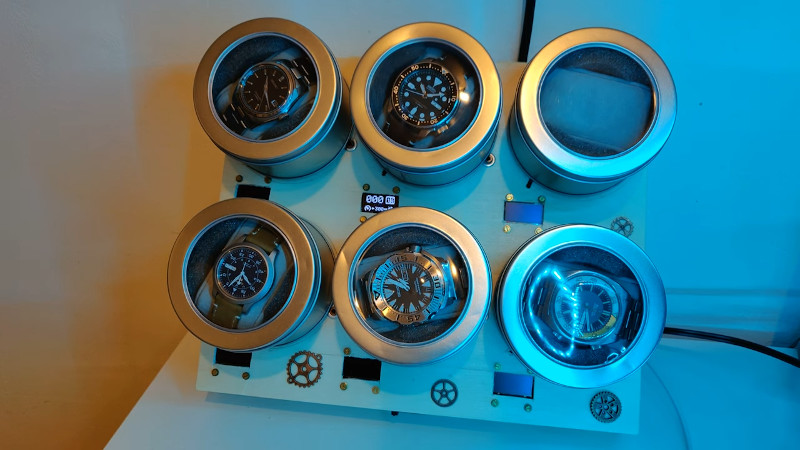Mechanical watches are triumphs of engineering on a tiny scale. Capable of keeping time by capturing the energy of the user’s own movements, they never need batteries changed. Unfortunately, they quickly lose time when not worn for a few days. To solve that problem, [sblantipodi] built a smart watch winder.
The overall build consists of six individual winder units. Each one has an ESP8266EX D1 Mini microcontroller, hooked up to a 28BYJ48 stepper motor with a ULN2003 motor driver. There’s also an OLED screen for status information. When commanded, the stepper motor turns, rotating a watch case to wind the timepieces. Control is via voice command, thanks to a Google Home Mini and a Raspberry Pi running Home Assistant. Watches can be wound individually, or all together, depending on the command given.
It’s a device that would serve any collector well, and could come in handy for watchmakers to wind customer watches waiting for pickup. Other similar builds have used special silent drives to ensure the device doesn’t disturb sleep when used on a bedside table. Video after the break.
















“Mechanical watches are triumphs of engineering on a tiny scale. Capable of keeping time by capturing the energy of the user’s own movements, they never need batteries changed. Unfortunately, they quickly lose time when not worn for a few days. ”
Just to clarify a point. As I understand it these self-winding watches are automatic or kinetic watches. “Mechanical” refers to any watch (or clock) that has gears but no quartz crystal oscillator or battery. Automatic watches are self-winding and mechanical. Kinetic watches are self-charging but not “mechanical” due to having a quartz and battery.
And many mechanical watches don’t have self-winding mechanics. Taking them for a spin isn’t going to wind them up. :-)
Isn’t a uln2003 just a darlington array? Not a stepper driver?
Correct.
Yup but they come with those 28BYJ48 motors for dirt cheap and work as a driver.
It’s nice that he can keep his automatic watches going. There shouldn’t be any problem with noise during the night, you’d just tell it not to wind the watches during the night, no need for expensive motors.
This thing does seem quite under-engineered to me though. What’s the point of being able to command each watch individually, why not one motor that turns them all? It would make (somewhat more) sense if it were designed to be modular and could distribute power and data so his watch collection could grow (and not clog up his wifi), but it isn’t.
While I don’t know about anything self-winding watches maybe different watches need a different amount of winding, some more, some less, and with multiple watches to wind it would make sense to command each individually. That’s my guess anyway.
This will also wear out your watch prematurely. How about instead of a machine that continuously winds the watches, it waits for the user to want the watch, and at that moment sets the time and winds the watch?
I’ve a Seiko one and I left it for years without winding it. Still had to replace the supercap after 8 years or so. I dont think it wears it out prematurely by winding it and besides leave it for a year and you have to set the time again.
Wrote long comment that got deleted (booo) short reply is that opposite is true. Automatics are designed to be constantly in motion. When stopped lubricants pool, gel and otherwise negatively affect the watch.
As I have read (after getting a vintage Tissot) the solidifying of lubricants is only a problem with older watches.
In modern watches modern lubricants are used that do not have that problem.
Any mechanical watch need proper regular maintenance anyway, and it cost arm and leg to do so.
It would be cool of the rotation of the watches formed the hands of a clock. Meta clock
How did he connect the axle motor to the watch’s container? And how did he stabilize the container from bending off the axle? Looks robust!
So he used enough computing power to support an entire Apollo moon landing to spin some watches? Something you can get on eBay for a hundred bucks or less? Wow…
Yep. A friend commissioned me to build a watch winder a number of years ago. I went overboard with a 555 timer.
that’s what I was thinking… using an esp8266 is understandable for WiFi connectivity and OK google integration (yuck), but 1 for every clock???
Well I suppose you could add a camera and an ai. But the best thing to do is have one good watch and just use it correctly. If it isn’t staying wound then put it on and go for a walk.